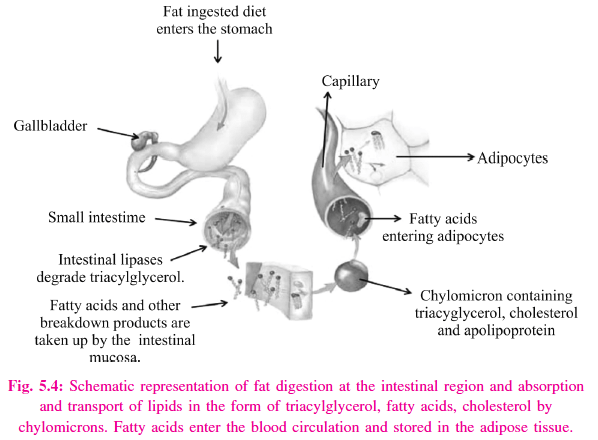Digestion And Absorption Of Lipids
The major lipids in the diet are triacylglycerols and, to a lesser extent,phospholipids. These are hydrophobic molecules and must be hydrolyzed andemulsified to very small droplets (micelles) before they can be absorbed. The fat-soluble vitamins – A, D, E, and K – and a variety of other lipids (including cholesterol) are absorbed dissolved in the lipid micelles. Absorption of the fatsoluble vitamins is impaired on a very low fat diet. Hydrolysis of triacylglycerols is initiated by lingual and gastric lipases that attack the sn-3 ester bond, forming 1,2-diacylglycerols and free fatty acids, aiding emulsification. Pancreatic lipase is secreted into the small intestine and requires a further pancreatic protein, colipase, for activity. It is specific for the primary ester links – ie, positions 1 and 3 in triacylglycerols – resulting in 2-monoacylglycerols and free fatty acids as the major end-products of luminal triacylglycerol digestion. Monoacylglycerols are hydrolyzed with difficulty to glycerol and free fatty acids, so that less than 25% of ingested triacylglycerol is completely hydrolyzed to glycerol and fatty acids. Bile salts, formed in the liver and secreted in the bile, enable emulsification of the products of lipid digestion into micelles and liposomes together with phospholipids and cholesterol from the bile. Because the micelles are soluble, they allow the products of digestion, including the fat soluble vitamins, to be transported through the aqueous environment of the intestinal lumen and permit close contact with the brush border of the mucosal cells, allowing uptake into the epithelium, mainly of the jejunum. The bile salts pass on to the ileum, where most are absorbed into the enterohepatic circulation. All long-chain fatty acids absorbed are converted to triacylglycerol in the mucosal cells and, together with the other products of lipid digestion, secreted as chylomicrons into the lymphatics, entering the blood stream via the thoracic duct. Free fatty acids are removed from the blood very rapidly and oxidized (fulfilling 25–50% of energy requirements in starvation) or esterified to form triacylglycerol in the tissues. In starvation, esterified lipids from the circulation or in the tissues are oxidized as well, particularly in heart and skeletal muscle cells, where considerable stores of lipid are to be found.

The free fatty acid uptake by tissues is related directly to the plasma free fatty acid concentration, which in turn is determined by the rate of lipolysis in adipose tissue. After dissociation of the fatty acid-albumin complex at the plasma membrane, fatty acids bind to a membrane fatty acid transport protein that acts as a transmembrane cotransporter with Na+. On entering the cytosol, free fatty acids are bound by intracellular fatty acid-binding proteins. The role of these proteins in intracellular transport is thought to be similar to that of serum albumin in extracellular transport of long chain fatty acids. Triacylglycerol is transported from the intestines in chylomicrons and from the liver in very low density lipoproteins. By definition, chylomicrons are found in chyle formed only by the lymphatic system draining the intestine. They are responsible for the transport of all dietary lipids into the circulation. Small quantities of VLDL are also to be found in chyle; however, most of the plasma VLDL is of hepatic origin. They are the vehicles of transport of triacylglycerol from the liver to the extrahepatic tissues (Figure 5.4).
